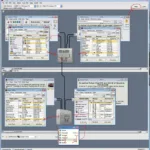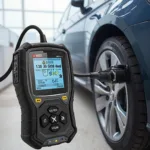The dreaded check engine light illuminates your Ford’s dashboard, and your OBD2 scanner reveals the cryptic code P1450. What does this mean, and how serious is it? This article delves into the Ford OBD2 code P1450, explaining its causes, symptoms, diagnostic procedures, and solutions. We’ll equip you with the knowledge to tackle this issue head-on.
Decoding the Ford OBD2 Code P1450
The P1450 diagnostic trouble code (DTC) specifically indicates a leak in the Evaporative Emission Control (EVAP) system. This system is designed to prevent fuel vapors from escaping into the atmosphere. A leak can compromise this process, leading to increased emissions and potentially affecting your vehicle’s performance. Understanding the intricacies of this system is crucial to effectively diagnose and resolve the P1450 code on your Ford.
Common Causes of P1450 in Ford Vehicles
Several factors can contribute to a P1450 code in Ford vehicles. These include a loose or damaged gas cap, a faulty purge valve, cracks in the EVAP lines or canister, and even a malfunctioning fuel tank pressure sensor. Identifying the root cause requires a systematic diagnostic approach.
- Loose or Damaged Gas Cap: This is the most common and easiest fix. Ensure the cap is tightened securely. Inspect the cap for cracks or damage and replace if necessary.
- Faulty Purge Valve: The purge valve regulates the flow of fuel vapors from the canister to the engine. A malfunctioning valve can disrupt this process and trigger the P1450 code.
- Damaged EVAP Lines or Canister: Cracks or leaks in the EVAP lines or canister can allow fuel vapors to escape. These components are often located under the vehicle and can be susceptible to damage from road debris.
- Malfunctioning Fuel Tank Pressure Sensor: This sensor monitors the pressure inside the fuel tank. A faulty sensor can provide inaccurate readings, leading to the P1450 code.
 Ford P1450: Inspecting the Purge Valve
Ford P1450: Inspecting the Purge Valve
Diagnosing the P1450 Code: A Step-by-Step Guide
- Retrieve the Code: Use an OBD2 scanner to confirm the P1450 code. Note any other codes that may be present.
- Inspect the Gas Cap: Check the gas cap for tightness and damage. Replace if necessary.
- Visual Inspection: Inspect the EVAP lines and canister for visible cracks or damage.
- Smoke Test: A smoke test can help pinpoint leaks in the EVAP system.
- Test the Purge Valve: Use a multimeter to test the purge valve’s electrical resistance.
- Check the Fuel Tank Pressure Sensor: Test the sensor’s voltage output using a multimeter.
What if I ignore the P1450 Code?
Ignoring the P1450 code can lead to further complications. While the immediate impact might be minimal, neglecting a leak in the EVAP system can eventually lead to increased emissions, failed emissions tests, and potential damage to other components.
“Addressing the P1450 code promptly is crucial,” says automotive expert, John Miller, ASE Certified Master Technician. “Ignoring it can lead to more costly repairs down the road.”
what does obd2 code p0455 mean
Fixing the P1450 Code: Solutions and Repairs
Once you’ve identified the root cause of the P1450 code, the appropriate repair can be made. This might involve replacing the gas cap, purge valve, EVAP lines, or fuel tank pressure sensor. In some cases, a simple tightening of the gas cap can resolve the issue.
“Regular maintenance and inspections can help prevent EVAP system issues,” adds Miller. “This includes checking the gas cap regularly and having the EVAP system inspected during routine service.”
Conclusion: Tackling the Ford OBD2 Code P1450
The Ford OBD2 code P1450 indicates a leak in the EVAP system. Addressing this issue promptly is essential to maintain your vehicle’s emissions compliance and overall performance. By understanding the causes, symptoms, and diagnostic procedures, you can effectively resolve this issue and keep your Ford running smoothly. obd2 code p1450 2005 mercury mountaineer
FAQ:
- What does the P1450 code mean? It indicates a leak in the Evaporative Emission Control (EVAP) system.
- What are the common causes of P1450? A loose gas cap, faulty purge valve, or damaged EVAP lines are common culprits.
- How do I diagnose P1450? Use an OBD2 scanner, inspect the gas cap, visually check EVAP components, and perform a smoke test.
- Can I drive with a P1450 code? You can drive short distances, but it’s best to address the issue promptly.
- How much does it cost to fix P1450? The cost varies depending on the cause and required repairs.
- Is P1450 serious? While not immediately critical, ignoring it can lead to further problems.
- How can I prevent P1450? Regular maintenance and inspections can help prevent EVAP system issues.
Common Scenarios for Ford OBD2 Code P1450:
- Scenario 1: Check engine light comes on after filling up the gas tank. Possible cause: Loose or damaged gas cap.
- Scenario 2: Fuel smell inside or around the vehicle. Possible cause: Leak in EVAP lines or canister.
- Scenario 3: Rough idling or poor fuel economy. Possible cause: Faulty purge valve.
Further Reading:
Check out our other articles on OBD2 codes and car maintenance tips.
Need assistance? Contact us via WhatsApp: +1(641)206-8880, Email: [email protected] or visit us at 789 Elm Street, San Francisco, CA 94102, USA. Our customer support team is available 24/7.

